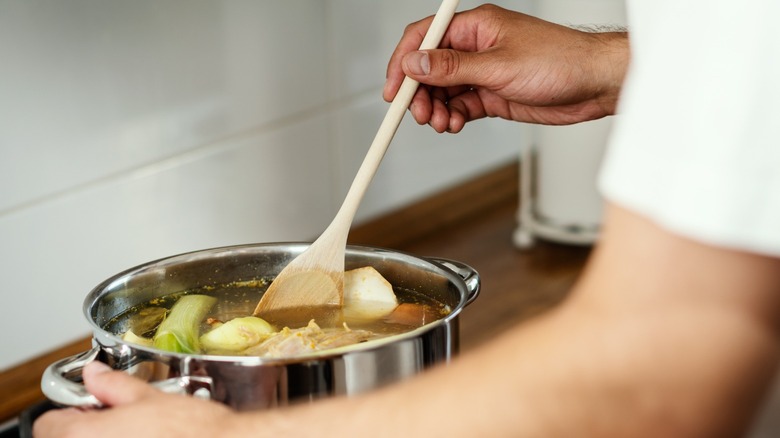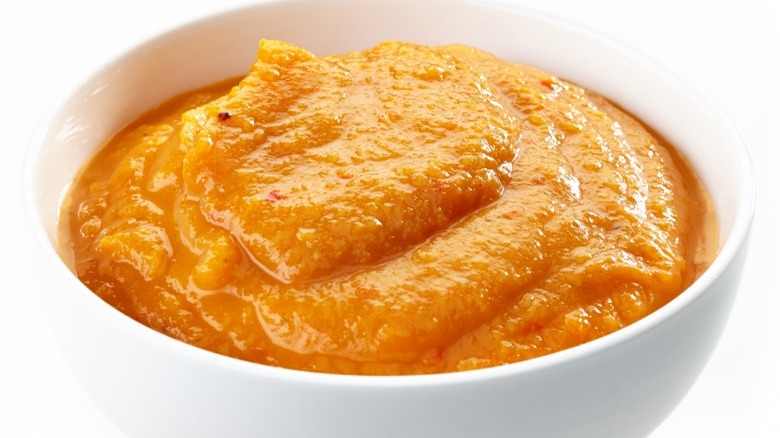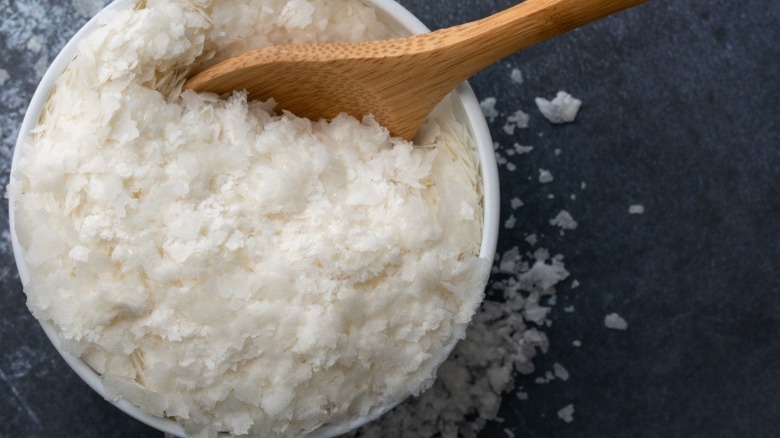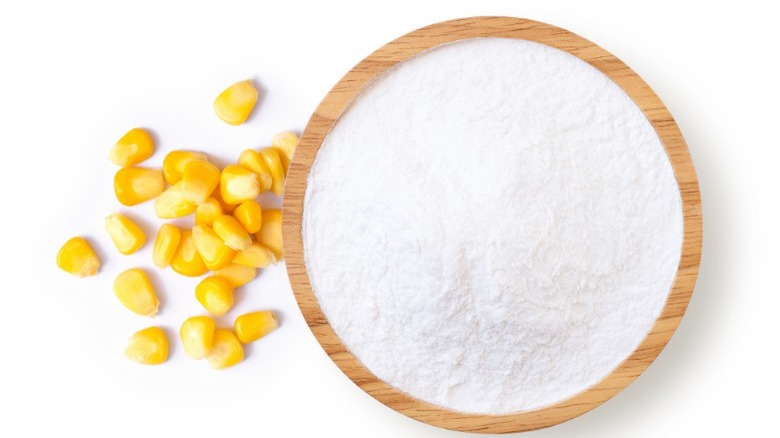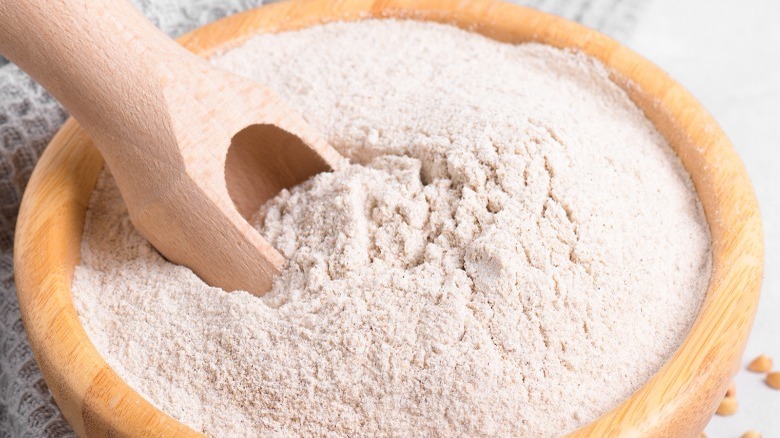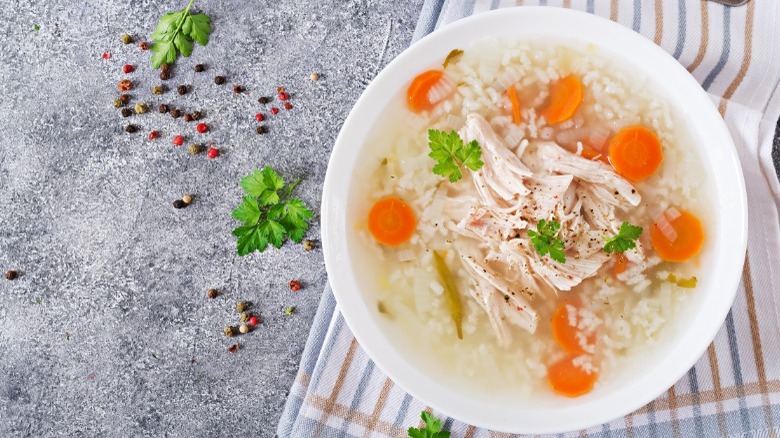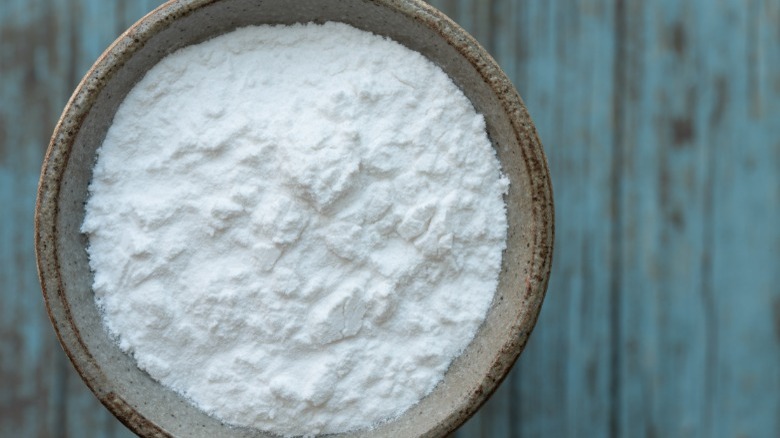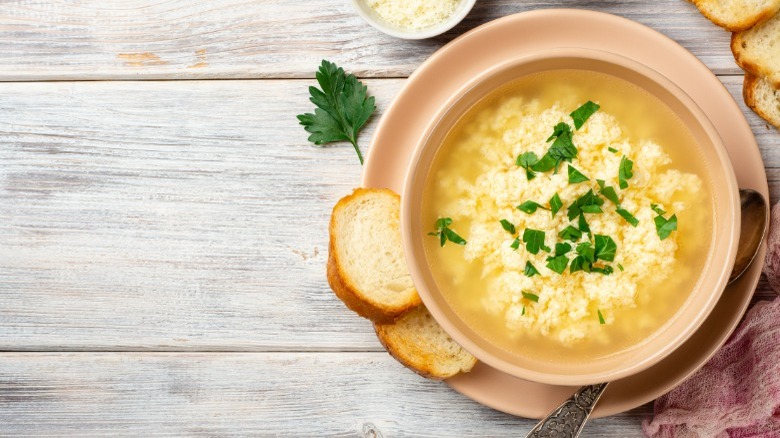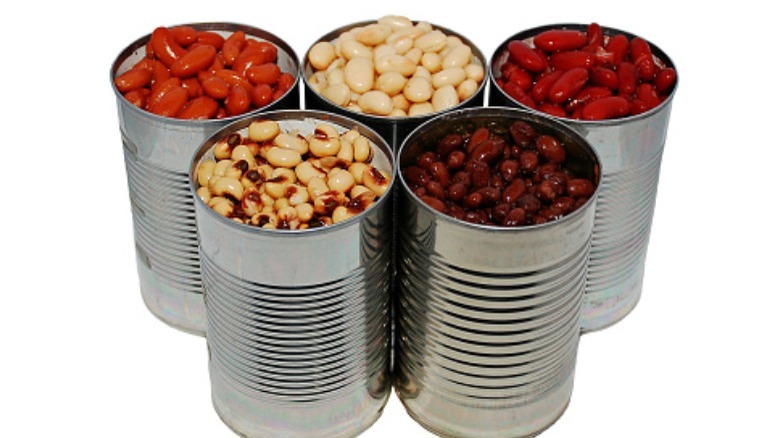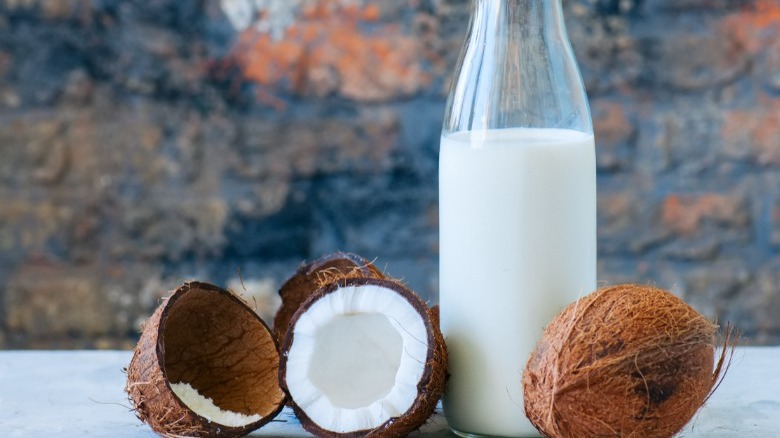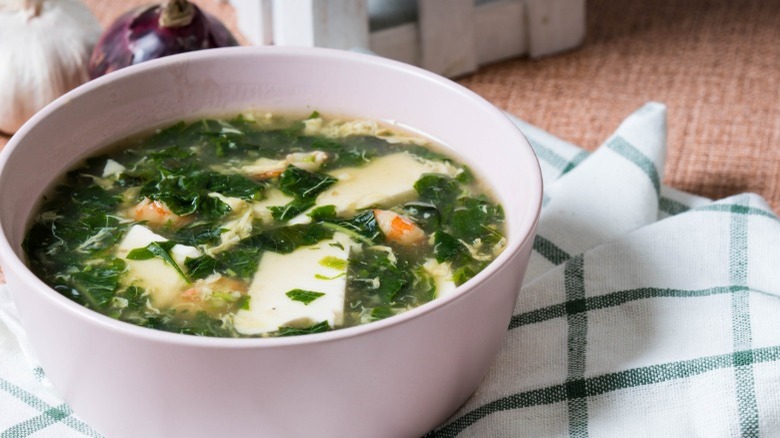12 Easy Ways To Thicken Your Next Soup
When soup recipes and canned soup descriptions contain the word "hearty," it can be a real selling point. After all, soup is comfort food, and its purpose is to make your belly full and happy. Soups with watery consistencies do just the opposite; they taste disappointing and leave you wanting something more substantial. Some canned soups are watery even when the instructions don't tell you to pour in liquid, and homemade soups might not be thick enough even when you follow the recipes closely.
Why do homemade soups come out too thin? According to Boss the Kitchen, too much broth or other liquid may have been added. It's also a bad idea to add frozen vegetables to soup, since they release even more liquid as they thaw. When you need to thicken a soup, your method will depend on the available ingredients, if you want to change the soup's taste, and whether or not it needs to be gluten-free.
One way to thicken a soup is to boil it until the liquid reduces, but this can only be done sparingly because too much of the soup might bubble away. Or, as the The Culinary Pro notes, you can add a thickening agent. Pureed vegetables can be added in to create bulk, while dairy products like milk, cream, and yogurt act like emulsifiers that combine with liquids already in the broth. Starches swell up and absorb excess liquids. These kinds of thickeners are more reliable than boiling, and there are a dozen of them listed below.
1. You'll love adding yogurt
Yogurt is an excellent thickening agent and works exceptionally well in creamy soups. According to Ricardo Cuisine, the two main ingredients in yogurt are milk and lactic acid bacteria. Options include Greek, almond, coconut, and regular yogurts, though you'll want to avoid using flavored ones if you don't want to change the taste of the soup. Plain ones can be used in any soup that would be fine with added dairy like sour cream, cream cheese, or milk. Yogurt can form clumps when added to hot soups, though. Before pouring it in, mix up a cornstarch paste, boil it (a microwave is fine), and blend it into the yogurt.
Everest Himalayan Cuisine notes that Greek yogurt can brighten up soups with a bit of tanginess and recommends it for creamy soups like potato and savory ones like minestrone. You can even use it to turn a bland chicken soup into a rich cream of chicken. We suggest adding a little bit at a time, whisking until blended and trying a spoonful. You can also plop it right on top after it's served.
Another benefit of adding yogurt: It's full of protein, calcium, and probiotics, according to Cleveland Clinic. Greek yogurt has even more protein than traditional versions. Read the labels, though, since some yogurts have more sugar than others.
2. Pureed vegetables
Most any kind of watery soup can be thickened up with pureed vegetables, and you probably know that we're going to tell you how healthy they are. Harvard T.H. Chan School of Public Health claims that eating a lot of vegetable can have benefits for blood sugar and heart health, among other (good) things. Cooking Tip of the Day adds that pureed vegetables are low in fat and will add color and flavor to soups. If there are already veggies in the soup, remove them with a slotted spoon and puree them in a blender or food processor with a bit of broth. Otherwise, cook fresh vegetables until very soft. Puree them, add to the pot, and stir until combined and heated.
Interestingly, vegetables take on a creamy consistency when pureed with a bit of liquid (like broth). Exploratorium explains how to easily make a creamy vegetable soup, and you can save the leftovers to thicken other soups: Good choices include zucchini, broccoli, squash, and carrot. Cut up the veggies into cubes and sauté with onions, shallots, garlic, herbs, and other aromatics. When they are very soft, just add your chosen broth — a good ratio is 1 cup of broth for every 2 cups of sautéed vegetables. An immersion blender works especially well for these kinds of soups and thickeners.
3. Potatoes are perfect
Leftover mashed potatoes can work magic on watery soups, or you can just pop one into the microwave to cook it for this purpose. Make sure the potato is very soft and let it cool before peeling. Mash it up well and add a bit of milk and butter if desired. Bring the soup to a low boil and add a little bit of the potato at a time, whisking well after each addition. Adding too much mashed potato can turn your soup into a strange side dish, so you'll want to keep checking the consistency.
An even faster way to use mashed potatoes involves packaged mashed potato flakes. Oregon State University's Basic Needs Center suggests adding 1 tablespoon of the stuff to 1 cup of liquid, mixing it up, and adding it to the soup. Remember not to mix thickeners like this with a lot of water, because that will thin out the soup. Instead, it's much better to scoop out some of the broth for this purpose. And if you like how the mashed potatoes thicken your soup, try making mashed potato soup.
4. Grab some bread
Soup and bread are a match made in heaven, with one of the tastiest examples being French Onion. In these recipes, bread or croutons are placed on either the bottom or top of the savory soup, which gets topped with cheese. The soup goes into a ramekin or other oven-safe serving bowl and is usually placed under a broiler to crisp the bread and melt the cheese. That all gets eaten with the thin broth, so you get a thicker texture in your mouth.
You can add chunks of bread to other soups, and we like adding a piece or two into serving bowls and eating them up before putting in any more. That way, the bread won't get as soggy. Or, let it sog up and then mush it into the broth with your soup spoon — whatever floats your boat. Another option is to add dried breadcrumbs to the bottom of your bowl before adding the soup.
Stale bread can work better than fresh since it has a harder texture and might not dissolve as quickly. Otherwise, the soup's texture could become pudding-like if you leave the bread in there for too long. Another option: Serve the bread on the side and keep dipping it into the soup and eating it. That will also absorb some of the excess liquid.
5. Cornstarch works well
This kitchen staple is great for thickening soups, as long as you have a whisk handy. Cornstarch also a good option for people on gluten-free diets. Beyond Celiac explains that corn doesn't contain gluten but advises checking cornstarch labels just to make sure. Cornstarch comes from ground-up corn grains and is sold in powder form; it is used by chefs all over the world who need to thicken soups, stews, gravies, and sauces. The Loopy Whisk adds that cornstarch is basically 100% starch with no other measurable ingredients. If you've ever used it, you've probably noticed its powdery, chalky consistency. It's not the same thing as corn flour, though. That's made from whole, dried corn cornels and contains starch, protein, fiber, and trace amounts of fat.
The Typical Mom likes cornstarch because it's lighter than flour, and a little goes a long way; you probably don't buy it that often. To use it as a thickener, set the soup to a low boil. Then, get a container that's deep enough for whisking, like a large coffee cup, bowl, or plastic container. Add twice the amount of water to the cornstarch — 1 tablespoon of the white powder to 2 tablespoons of cold water is a good slurry starting point. Whisk until smooth (no lumps permitted), drizzle it into the soup, and use your whisk or a mixing spoon to combine. You may need to repeat this process a few times until you get the right consistency.
6. Find some flour
Flour can thicken up watery soups in much the same way as cornstarch, but both thickeners can clump up in soups and gravies. Pro Family Chef advises against using hot liquid in these thickening pastes or pouring them into high-boiling soups. And while some people might want to skip the first step, flour (or cornstarch) should never be poured right into soup. Add in the slurry, let the soup continue cooking for 10 minutes, and stir often.
A slurry isn't the only way to thicken soups with flour; a French thickener called beurre manié does it a bit differently. By the way, "beurre manié" means "butter mania" in English, so you can think of yourself as an eccentric French chef when making it. Rouxbe explains that this thickener is made from a 50-50 ratio of softened butter and flour. (Plant-based butter is fine, though you might need more flour.) You can mix it up with your hands or a spoon and drop small bits of it into soup on a low boil. Like other thickeners, you'll want to add beurre manié during the last 10 minutes or so of cooking.
One other thing — beurre manié is not the same thing as beurre monté, which is another French thickener in which softened butter is mixed into warm water. Beurre monté gets added to gravies to smoothen them and is not an effective soup thickener.
7. Rice is the right thickener
Rice soups are quite filling, and the grains can be added cooked or uncooked. Livestrong notes that adding uncooked rice means longer cooking times and having to add extra water: Rice absorbs water as it cooks, so you might end up with a rice entree if you don't account for that. Uncooked brown rice tends to take longer to cook than white rice, and you might need to add 20 to 35 minutes more cooking time after the grains are added.
It's a good idea to remove cooked proteins and vegetables from the soup before putting in the rice because they can get overcooked and become tough or mushy. Take them out with a slotted spoon and let them rest; don't keep them heated or they will continue cooking. You can return them to the pot once the rice is cooked, and they'll warm up in a few minutes on low heat.
The Nibble adds that adding cooking rice in soups thickens them better than adding already cooked rice does. That's because the starch in the rice breaks down during cooking and gets into the broth. And the longer you cook and stir it, the thicker it gets. With cooked rice, just add it to the soup a few minutes before serving. Be careful with the leftovers, though. These soups don't store well since the rice continues absorbing the liquid as it sits. You can try straining the soup with a colander, and then store the liquid and other ingredients in separate containers.
8. Try some arrowroot
Here is another good thickening agent for people on gluten-free diets – arrowroot flour. According to Bob's Red Mill, arrowroot is a tropical plant that can be compared to yucca, and the flour is also referred to as arrowroot powder. And like cornstarch and wheat flour, arrowroot is white and flavorless. Some of these products are processed, so you may want to read the ingredients before buying any. Arrowroot is used just like cornstarch and flour; you create a slurry with cold water or a bit of broth. This source also mixes it with plant-based milk and recommends it for thickening gravies, sauces, and gluten-free baking.
Arrowroot powder tends to cost more than other flour since it is more of a specialty item. Amazon shows a price range of about $5-12 per pound, and, as you might expect, the organic versions are more expensive. Corn flour will also be priced higher when compared to wheat flour. You can usually buy a 5-pound bag of the latter for around $5 or less at your grocery store.
9. Whip in an egg (or yolk)
If you like Chinese egg drop soup, you can use the same cooking technique to thicken soups at home. The egg(s) get beaten and poured into the hot soup and form light-colored strands that fill up the pot or bowl. That's not the only way to thicken soups with eggs, though.
Mark's Daily Apple suggests that you separate the eggs and only use the yolks: The trick is to temper them first. In other words, the yolks must be warmed up to the soup's temperature before they are added in. Simply scoop out a cup of the broth, add it to one egg yolk, and mix them up. If the soup doesn't thicken up as expected, try it again with another yolk — you're not adding more liquid since you're combining the yellow stuff with the broth. The key here is to have the soup at the proper temperature. if it's too hot, the eggs will scramble; too low, and things could get slimy.
The Sporkful recommends using whole eggs. But instead of beating them first, crack them and add them in, whites and yellows, when the soup is almost finished. The hot broth quickly poaches the eggs, and the whites get lacy, just as with a Chinese egg drop soup. The yolks partially solidify into a gel-like texture, and both parts of the egg work to make a broth tastier and more substantial.
10. Add canned beans
Uncooked, dry beans have to be soaked and cooked for at least 45 minutes, according to the University of Nebraska-Lincoln's Institute of Agriculture and Natural Resources. And while uncooked beans will have less salt and processed ingredients, a faster way to use beans to thicken soups is to just grab a can of them from your pantry. If you are concerned about the sodium, you can rinse the beans. The Bean Institute recommends doing this by emptying a can of beans into a colander in the sink. Allow two minutes for the liquid to drain off, rinse the beans with cool water, and wait two more minutes. How easy is that?
Frugal Cooking shares a few methods for thickening soup with beans. If you are already making bean soup and it's too thin, fish out some or all of the beans. These can be quickly pureed with just a bit of broth. Both options will create a thicker, silky-smooth consistency, but when you leave some of the beans in there, you'll have a nice thick/chunky texture after the pureed ones are added in. Frugal Cooking also recommends using canned beans and leftover refried beans; that last option would be great in a homemade Southwestern pork and bean soup.
11. Coconut milk thickens soup
Coconut milk is dairy-free and can thicken soups and add extra flavor. First things first, though: Healthline explains that coconut milk is not the same thing as coconut water. The milk is made from the white flesh of mature coconuts, while coconut water is sourced from unripe, green coconuts. The mature coconuts' flesh becomes rich and creamy after it's combined with water; the ratio is about 50-50. (Coconut water is 94% water, so you don't want that).
Great British Chefs prefers additive- and preservative-free coconut milk and states that these are usually sold in tins. You can also find it in large cans and your grocer's refrigerated section. There are unflavored, flavored, sweetened, and unsweetened versions. Try adding just ¼ cup to start and taste the soup. Unless you want the soup to taste like coconut (that's not necessarily a bad thing), use a light hand. Once the soup starts simmering again, it should reduce and have a nice sheen and thicker consistency.
12. Thicken soup with tofu
Tofu is packed with protein and is sold fresh, dried, or fried. It's a fine choice if you want to thicken, but not add flavor, to a soup. According to UnlockFood.ca, tofu is made from soaked, boiled, and drained soybeans, so it is vegan, dairy-free, and sometimes gluten-free. Dried tofu has to be soaked before getting added to soups. Fresh tofu is best for thickening, and you can find several versions: extra firm, firm, medium, soft, and silken. Tofu is packed with protein, low in saturated fat, and must be kept refrigerated until you're ready to use it.
Thrive Cuisine advises against using silken tofu in soups because it tends to fall apart; the other kinds can be used cooked or uncooked. If you have a tofu press, use that to squeeze out the excess water after removing the tofu from its packaging. Tofu doesn't harden up after cooking in soup or other liquids but can be baked or fried. Home Kitchen Talk recommends sprinkling soft tofu into soups and blending silken tofu into soups to thicken them.
